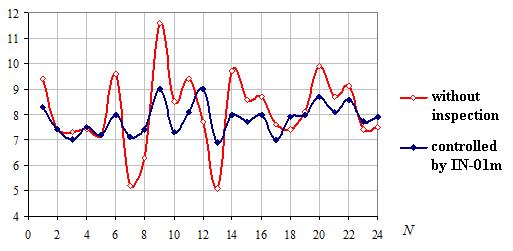Search:
PROVIDING AN OPTIMAL TIGHTENING EFFORT OF STEEL STUDS AND BOLTS
BY IN-01M THE METAL STRESS INDICATOR
BY IN-01M THE METAL STRESS INDICATOR
General condition of reliability and durability of
threaded joints in the housing power engineering equipment is the uniformity
of steel studs and bolts tightening effort distribution on each joint of housing parts.
The housing production for energy engineering is usually not typical, it is seems difficult to maintain and recovery due to exceedingly complex shape and high metal-consumption. Much easier and cheaper is to replace the steel studs broken or damaged, so the margin of durability of steel studs is always should be chosen significantly lower than durability of the housing.
In order to remain the reliability of housing equipment after this on the former high level the regular inspection of the actual stressed state of steel studs and bolts metal should be regularly carried out, which would be provided most easily and effectively by IN-01m the metal stress indicator..
The steel studs fastening the high-pressure preheaters (HPP) housing may have the diameter of rod from


Fig.1. A tightening of steel studs on the
high-pressure preheaters is usually implemented by enclosed steel cap nuts
In this case given the inspection of steel studs tightening
effort by IN-01m the metal stress indicator has to be carried out on the lateral surface
of ones, in the middle of their rods, which could not to dodge by convenient techniques,
e.g. acoustic tension measure technique.
The magnetic inspection of steel studs tightening
effort on the HPP carried there are as weakly tightened studs, as overtightened detected
(figure 2). The largest deviations of the HPP steel studs tightening effort from the
average level was from –37% to +43%.
Br, мТл

Fig.2. The metal stress distribution on the HPP
steel studs before and after handling under IN-01m the metal stress indicator control
After repeating the manual tightening of selected HPP steel studs
under IN-01m the metal stress indicator control the largest deviations of steel studs
tightening effort from average level is not exceeded 15%.
Inspecting the steel studs fastening the steam turbine
housing during the maintenance of facility the high-stressed steel studs detected
with stress level exceeded the average for 1.5-2 times and replaced by new ones
(shown by red labels on the figure 3).

Fig.3. A results of residual stress of steel studs metal
inspection by IN-01m the metal stress indicator after demounting steam turbine cover
During the maintenance period less for a half
of service day the 250 steel bolts and studs of different types and gauges inspected
by IN-01m the metal stress indicator: steel studs fastening the steam
turbine housing, joints of hydropower unit stator to the fundament, etc.
As another one example the results of steel studs
(fastening a cover of the hydropower unit) tightening effort inspection by IN-01m the
metal stress indicator is presented on the figure 4.


Fig.4. Cover of the hydropower unit turbine and results of its steel studs tightening effort inspection by IN-01m the metal stress indicator
The distribution of steel studs tightening effort
observed on the figure 4 is also not uniform. The tightening effort of steel studs
number 3, 5, 9, 28 is exceeded significantly from conventionally admissible level taken,
steel studs number 25, 26 have too low level of tightness.
On results of the tightening effort of steel studs and bolts inspection during the maintenance the activities to provide the uniform level of tightening effort of threaded joints needed are carried out in the housing equipment inspected.